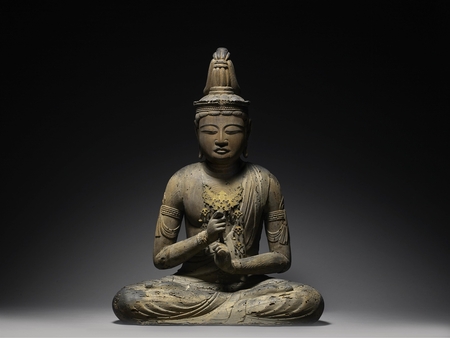Product Description
7677 A wood figure of Dainichi Nyorai (Mahāvairocana) wearing flowing robes and seated in kekka-fusa (lotus position), his hands in chiken-in mudra (Mudra of the Knowledge Fist), the hair is arranged in a tall standing top knot above the crown
The arms and wrists are decorated with carved armlets and bracelets and the chest is bejewelled with a gilt metal munakazari (pectoral ornament) with semi-precious stone beads.
Japan 10th/11th century Heian period
Dimensions: H. 67.5cm x W. 49.5cm x D. 34cm (26¾” x 19½” x 13½”)
On the inside of the figure are two illegible characters inscribed in ink.
Dainichi (Great Sun) is the central and supreme deity of the pantheon of Esoteric Buddhism. In origin he has been linked to an ancient sun cult and to the Zoroastrian god of light, Ashura Mazda. In Brahmanical literature the appellation Vairocana (primordial or supreme Buddha) appears, for example, as the name of a legendary king and of the king of the Ashura. In Buddhism he assumes a central role in Esoteric Buddhism he eventually took the place of Shaka (the Historical Buddha), as expositor of the Buddhist teachings, becoming the central figure in the Esoteric Buddhist pantheon as represented by the Taizokai Mandara (Womb World Mandala) and Kongokai Mandara (Diamond World Mandala). In Japan Dainichi also figures among the so-called Jusanbutsu (Thirteen Buddhas), presiding over the memorial service held on the 12th anniversary of a person’s death.
Dainichi differs iconographically from other Buddhas in that he is represented in the form of a Bosatsu, seated, wearing silk robes and accessories such as armlets and bracelets, and having long locks of hair. He also wears a Gochi Houkan (five-wisdom bejewelled crown) on his head, symbolising his identity with the Gobutsu (Five Buddha) and Gochi Nyorai (the five wisdoms) attributed to them.
Dainichi may be identified by his distinctive hand-gestures: in the Taizokai Mandara he forms the hokkai jouin (Concentration seal of the Dharma-realm), with both hands lying on his lap, right on top of left, palms upward and thumbs touching, while in the Kongokai Mandara he forms the chiken-in (seal of the knowledge fist), with the clenched right hand posed over the extended index finger of the otherwise clenched left hand.
For similar examples of Dainichi Nyorai see:
Nara National Museum ed., The Buddhist Master Sculptor Kaikei: Timeless Beauty from the Kamakura Period, (Nara, 2017), no. 56 (by Kaikei, 12th-13th century, Tokyo University of Arts)
Tokyo National Museum ed., Japanese Sculpture of the Kamakura Period, (Tokyo, 1975), no. 3 (dated 1183, Important Cultural Property, Yokokuraji temple, Gifu)
Miho Museum et al eds., Omi: Spiritual Home of Kami and Hotoke, exhibition catalogue, (Kyoto, 2011), p. 205, no. 28 (Kamakura period, 13th century, Saimyo-ji Temple, Shiga).
For a Kokuzo Bosatsu figure with similar hair style see Asia Society Museum ed., Kamakura: Realism and Spirituality in the Sculpture of Japan, (New Heaven and London, 2016), p. 58-59, no. 5 (ca. 1200, Museum Rietberg Zurich).
Radio Carbon Dating Ref: RCD-9213









